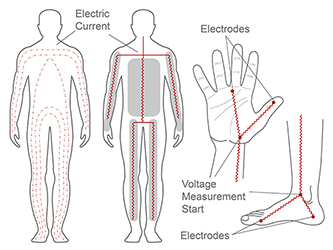-
When is the best time to measure weight or body fat?
Daily activities, such as food, exercise, and dehydration can affect measurement results. Oserio recommends measuring weight and body fat in the morning, to minimize variables and receive the most reliable and consistent results.
Ideally, you should conduct measurements in the same environment and time of day, to further reduce variables and receive the most accurate body composition calculations. -
Who should not use BIA Body Fat scales?
Oserio body fat scales utilize Bioelectrical Impedance Analysis (BIA) to calculate body composition. BIA should not be used by subjects with the following characteristics:
(1) Electronic medical implants, e.g. cardiac pacemaker
A low level imperceptible electrical current will be sent through the body during measurement, which may damage the implanted device or result in malfunction.
(2) Prosthetics and amputation
BIA measures impedance measured using an electric current sent through the body through electrode contact points. As the current cannot flow through prosthetic limbs, measurement is not possible.
(3) Pregnant Women
BIA equations are created based on statistical analysis of sample populations. If subject's body composition differs significantly from these sample populations, equations derived from "normal" healthy adults will be inherently less accurate in these subjects. Women undergo a wide range of body composition changes during pregnancy, including but not limited to change in fat percentage and body water. Without dedicated algorithms, pregnant women should use results with caution and professional advice.
-
What is the correct way to use a scale?
Before measurement, a scale should be placed on a flat, solid, non-slippery floor. If used on carpet or uneven ground, measurement results may be less accurate. -
What's the difference between weight scales and body fat scales?
In addition to measurement of weight, body fat scales also utilize Bioelectrical Impedance Analysis (BIA) to calculate body fat and other body composition, allowing users to better undertand their body's current status. -
How do BIA Body Fat scales work?
Bioelectrical Impedance Analysis (BIA) is a safe and well-established technology for calculation of body composition. BIA sends a safe, imperceptible electrical current through the body, measuring impedance as it travels through different body tissue. Oserio's algorithms then combine measured data (impedance, weight) with input data (ex: height, age, weight, gender) to calculate body composition.
Why does this work? BIA utilizes the fact that water is a good conductor of electricity to calculate results. For example, fat has low conductivity, whereas muscle (being high in water) has better conductivity.
If input data is incorrect (ex: height), measurement results may be less accurate!
